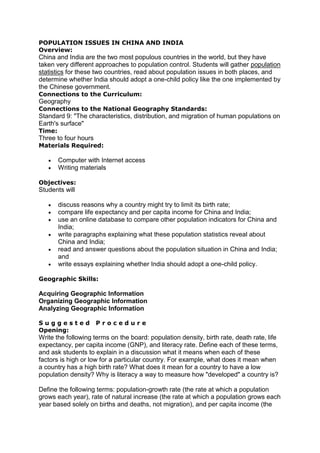
Population issues in china and india
- 1. Population Issues in China and India<br />Overview:<br />China and India are the two most populous countries in the world, but they have taken very different approaches to population control. Students will gather population statistics for these two countries, read about population issues in both places, and determine whether India should adopt a one-child policy like the one implemented by the Chinese government. <br />Connections to the Curriculum:<br />Geography <br />Connections to the National Geography Standards:<br />Standard 9: quot; The characteristics, distribution, and migration of human populations on Earth's surfacequot; <br />Time:<br />Three to four hours <br />Materials Required:<br />Computer with Internet access <br />Writing materials <br />Objectives:<br />Students will <br />discuss reasons why a country might try to limit its birth rate; <br />compare life expectancy and per capita income for China and India; <br />use an online database to compare other population indicators for China and India; <br />write paragraphs explaining what these population statistics reveal about China and India; <br />read and answer questions about the population situation in China and India; and <br />write essays explaining whether India should adopt a one-child policy. <br />Geographic Skills:<br />Acquiring Geographic Information Organizing Geographic Information Analyzing Geographic Information <br />S u g g e s t e d P r o c e d u r e <br />Opening:<br />Write the following terms on the board: population density, birth rate, death rate, life expectancy, per capita income (GNP), and literacy rate. Define each of these terms, and ask students to explain in a discussion what it means when each of these factors is high or low for a particular country. For example, what does it mean when a country has a high birth rate? What does it mean for a country to have a low population density? Why is literacy a way to measure how quot; developedquot; a country is? <br />Define the following terms: population-growth rate (the rate at which a population grows each year), rate of natural increase (the rate at which a population grows each year based solely on births and deaths, not migration), and per capita income (the average amount of money each person in a country earns per year). Inform them that these concepts will be helpful later in the lesson. <br />Can students think of reasons why a country might take action to limit the number of children its citizens are allowed to have? Ask them if they have heard of China's one-child policy, and inform them that they are going to learn more about this policy and compare China's population situation with that of India. <br />Development:<br />Have students compare the life expectancy and per capita income statistics for China and India, using the CIA World Factbook. Have them state in a class discussion what these numbers show about these two countries. <br />Have students go to the Your Nation site and click on quot; Compare.quot; Ask them to compare China and India on the following indicators: birth rate, death rate, literacy rate, and infant mortality. As they view the comparisons, have them record the numbers they see. It would be helpful for them to make charts that display the information in an orderly way. <br />Have students write paragraphs analyzing the statistics they have found. Their paragraphs should answer the question quot; What do these numbers reveal about China and India?quot; Students should provide specific examples from the statistics to support their responses. <br />Have students check out PBS's Six Billion and Beyond, plus any other Internet or print resources they can find, to learn more about the population situation in China and India. As they conduct their research, ask them to answer these questions for each country: <br />What is this country's birth rate? <br />What factors contribute to this country's birth rate? <br />What is the government's role in this country's growth rate? <br />Closing:<br />Discuss the answers to the above research questions as a class. <br />Suggested Student Assessment:<br />Have students write essays answering the question quot; Should India have a one-child policy like China's? Why or why not?quot; They should provide specific examples from their research and discuss the differences between China and India that have an impact on the population situation in each country. <br />Extending the Lesson:<br />Ask students to hypothesize the economic reasons why people might want to have smaller families. In particular, how might limiting the number of children in a family affect the family's ability to earn and save money? Can students think of examples of the reverse scenario, in which it would make more financial sense for a family to have more children? Students can continue their research to find out what scholars and population activists say about these questions. <br />Related Links:<br />National Geographic: Xpeditions Activity—Population PastaPBS: Six Billion and Beyond—Population in the New MilleniumPopulation Action International<br />
